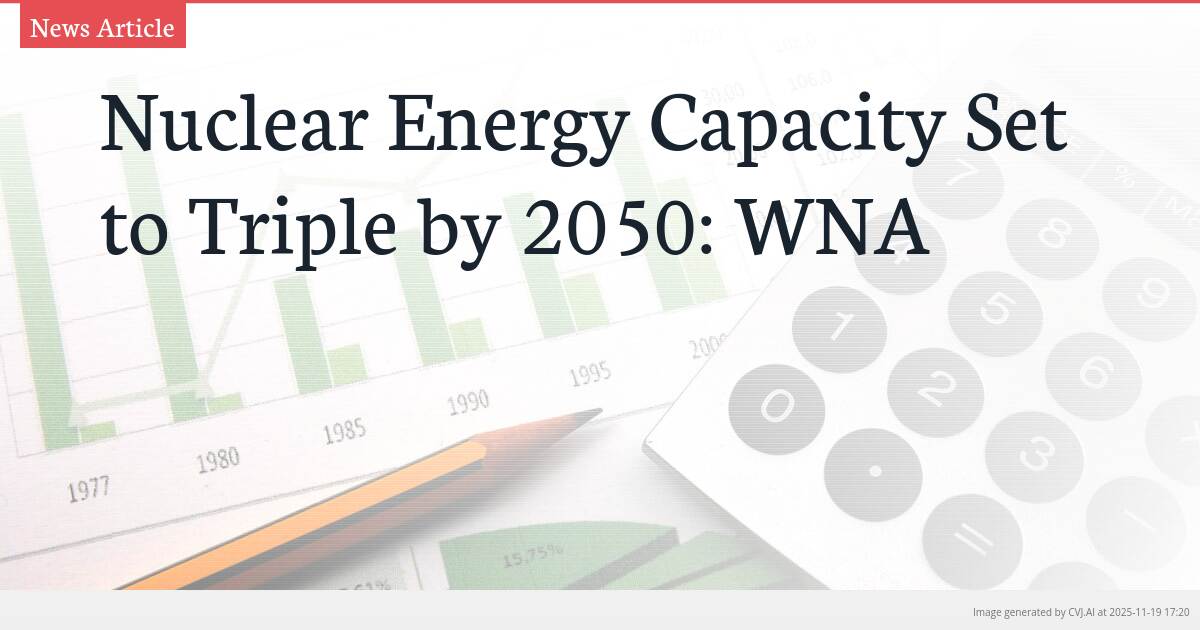Introduction
Global nuclear energy capacity is projected to reach 1,428 gigawatts by 2050, substantially surpassing the previously established 1,200 GWe target according to the World Nuclear Association’s 2025 Outlook Report. Presented at the COP30 climate conference, these projections signal a fundamental shift from theoretical goals to a quantified implementation roadmap, marking one of the most significant energy transformations in decades as nations accelerate nuclear infrastructure development for reliable, low-carbon baseload power.
Key Points
- Nuclear capacity projected to reach 1,428 GWe by 2050, exceeding the 1,200 GWe target
- Findings released in World Nuclear Outlook Report 2025 at COP30 climate conference
- Represents a fundamental shift from theoretical goals to quantified implementation roadmap
From Aspiration to Quantified Roadmap
The global push to triple nuclear energy capacity has evolved from ambitious aspiration to concrete implementation strategy, according to the World Nuclear Outlook Report 2025 released by the World Nuclear Association at COP30. The report projects that global nuclear capacity is on track to potentially reach 1,428 gigawatt electrical (GWe) by 2050, significantly surpassing the previously established 1,200 GWe goal. This represents a fundamental transformation in how the international community views nuclear energy’s role in the global energy mix.
The accelerated timeline reflects increased government and industry commitment to nuclear infrastructure development as nations seek reliable, low-carbon baseload power solutions. The World Nuclear Association’s findings indicate that what was once considered an ambitious target has now become a measurable, achievable pathway. The projection of 1,428 GWe by 2050 demonstrates the growing confidence among policymakers and industry leaders in nuclear energy’s capacity to deliver substantial clean energy at scale.
COP30 as a Turning Point for Nuclear Energy
The release of the World Nuclear Outlook Report 2025 at COP30 marks a significant milestone in international climate discussions, positioning nuclear energy as a central component of global decarbonization strategies. The timing and venue of the report’s release underscore the growing recognition among climate negotiators and policymakers that nuclear power must play a critical role in achieving net-zero emissions targets. The COP30 platform provided the World Nuclear Association with a global stage to present these compelling projections to an audience of climate leaders and energy ministers.
The report’s presentation at one of the world’s premier climate conferences signals a shift in how nuclear energy is perceived within international climate diplomacy. Rather than being sidelined in climate discussions, nuclear power is increasingly being recognized as an essential tool for reducing carbon emissions while maintaining energy security. The World Nuclear Association’s data-driven approach at COP30 helped reframe the conversation around nuclear energy from ideological debates to practical solutions for meeting climate goals.
Infrastructure Implications and Investment Opportunities
The projected expansion to 1,428 GWe by 2050 represents a near-tripling of current global nuclear capacity, requiring unprecedented levels of investment in nuclear infrastructure, technology development, and workforce training. This massive scale-up will necessitate coordinated efforts across government, industry, and financial sectors to develop the supply chains, regulatory frameworks, and skilled labor required to support such rapid growth. The World Nuclear Association’s projections provide a clear signal to investors and infrastructure developers about the long-term trajectory of nuclear energy development.
The substantial exceedance of previous targets—from 1,200 GWe to 1,428 GWe—indicates stronger-than-expected momentum in nuclear energy adoption worldwide. This acceleration reflects growing recognition among policymakers that nuclear power provides reliable baseload electricity that complements intermittent renewable sources like solar and wind. The infrastructure requirements for this expansion will create significant opportunities across the nuclear value chain, from uranium mining and fuel fabrication to reactor construction and waste management solutions.
As reported by ETF Trends, the World Nuclear Association’s strengthened projections underscore the growing investment case for nuclear infrastructure. The clear, data-backed roadmap provides investors with greater certainty about the long-term growth trajectory of nuclear energy, potentially attracting capital to companies and projects positioned to benefit from this expansion. The transition from aspiration to quantified implementation plan reduces uncertainty and creates more predictable investment conditions for the nuclear sector.
📎 Source reference: etftrends.com

